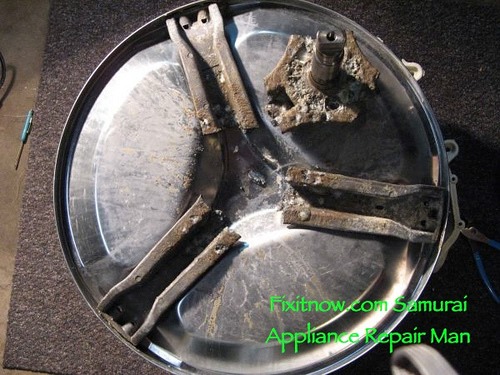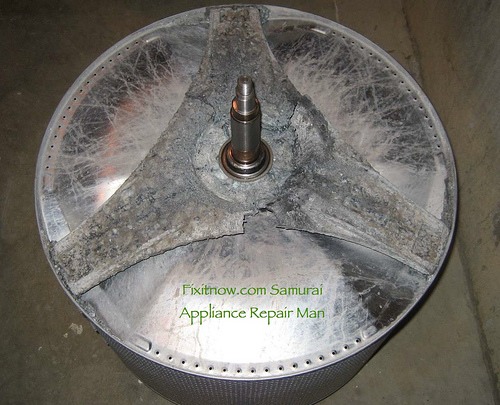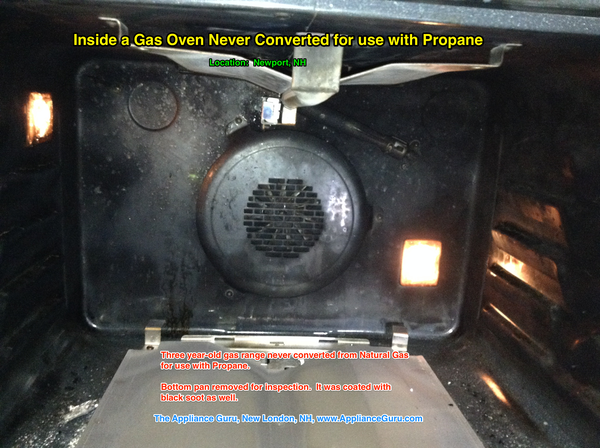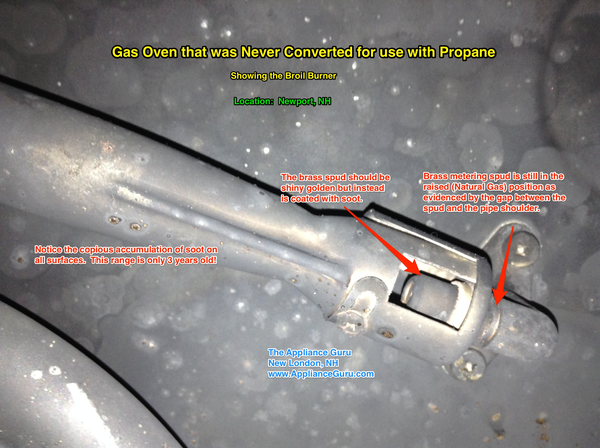Blog
Diagnosing Catastrophic Front Load Washer Drum Bearing and Inner Basket Failures
Front Load Washers Rule!
First, lemme start off by saying I love front load washers. I think they offer the best clothes washing technology out there combining low water use with a gentle tumble wash that's easy on the fabrics, making your clothes last longer, and does a very thorough job of cleaning the clothes compared to the high efficiency (HE) top load washers.
We're a family of five with dogs and cats. We've used a front load washer for over 16 years at our house and, aside from routine repairs, have never had any washability or odor complaints. You'll hear some people complain about these issues with their front loader but, in almost every case I've seen during service calls, it's been due to user error-- usually using too much or the wrong type of detergent.
The Economics of a Repair
Okay, so front load washers: rah-rah, go team go. Why have a special post dedicated to front load washer drum bearing and inner basket failures?
Because these failures are usually considered a "total" event (as in "Dude, I totalled my car last night") by professional Appliantologists due of the huge cost of the repair. Not only are the parts expensive (sometimes more than $500) but the job itself can take more than three hours (depending on the particular nightmares you run into) and usually require a second man... or one with a very strong back, though it may not be after completing one of these repairs solo!
Everything is repairable. The question is: does it make economic sense to do the repair?
There are two circumstances where it may make economic sense to repair a failed drum bearing or inner basket support spider:
1. You are going to do the repair yourself, so you're only paying for parts.
2. The machine is still under full or partial manufacturer's warranty and some or all of the cost of the repair will be covered.
So, if you're in a situation where neither of the above conditions apply, wouldn't it be nice if you could positively diagnose a bearing or basket failure on your own and at least save yourself the cost of a service call? Ya sure, ya betcha! And hence, the raison d'être for this post.
How to Tell if Your Washer has Bad Drum Bearings or a Broken Inner Basket
Okay, enough talk. Let's do some basic watching and listening.
1. Broken Inner Basket
The inner basket is supported in the back by a special metal structure called a "spider." The spider has three support members that extend from the basket hub to the outer perimeter. A common failure is for the support members to corrode by galvanic corrosion, eventually weakening the metal to the point that it breaks. Here's an example of what that looks like, this particular washer is a Frigidaire but this is typical regardless of brand:

Here's another example, but this is from a GE front loader:

What you see in these photos is called galvanic corrosion. Various theories abound as to whence cometh this galvanic doo-doo. Some of the more plausible ones include:
- Dissimilar metals used in the support members vs. the basket metal itself.
- Certain combinations of hard water and detergents.
- Running the washer on a non-grounded or improperly grounded outlet.
Regardless of the cause, which is a whole separate and interesting engineering discussion, if this happens to your washer, your immediate tasks are to 1) properly and positively identify this failure and 2) decide whether to repair or replace based on the economics of the situation.
2. Bad Drum Bearings
This failure usually manifests as a roaring noise during the spin cycle. This first video demonstrates the tell-tale sound of bad drum bearings:
In advanced stages of this failure, you can also diagnose bad bearings manually using this technique:
Ruh-row, trouble in washer-land! These drum bearings are factory-pressed into the back half of the drum. So it's not like you can buy a set of OEM bearings, pop 'em in and off you go. You have to replace the whole drum, at least the back half, with the factory-installed bearings. Problem is that you'll usually find the drive shaft on the inner basket so corroded that you'll need to replace the inner basket at the same time. Double whammy!
If you look around the Internet, you'll find third-party bearings that claim to be a drop-in replacement for the factory-installed bearings. I've not heard of a single case of this repair lasting more than a few months. If you've done this repair and have gotten longer than a year out of it, send me proof and you'll be a rock star.
The reason these third-party bearings have such a dismal reliability record is because the tolerance on these bearings is astonishingly tight. When you consider the pressure and speeds that these bearings need to work in, it's amazing they last as long as they do. These bearings are actually a precision-machined piece and that's why they have to be installed at the factory for maximum reliability.
What about Protection Plans or Extended Warranties for New Appliances? Are they worth buying?
I get asked about new appliance protection plans and extended warranties a lot both during real-life service calls as The Appliance Guru and via emails from my DIY appliance repair site. So, FWIW, I thought I'd offer my contemplations and musings on the topic.
First off, you gotta realize that protection plans and extended warranties are only as good as the people offering or doing the actual service work. Protection plans are basically a form of insurance. Lots of companies wants to get in on the protection plan biz because, structured correctly, it’s a highly lucrative arrangement: you pay a chunk of money for service that the warranty company is betting you won’t need. Insurance companies have this game figured out in all aspects of our lives, including home and appliance warranties.
But there’s one big difference.
In auto, home, and medical insurance, for example, all the insurance company has to do is write a check for a claim. Insurance companies are all about cash so even writing big checks are no problem for them.
Now consider an appliance repair insurance plan— which is basically what protection plan and extended warranties are. When a claim is made, what’s the payout? Instead of a check, the payout is usually a repair. And herein lies the dirty little secret about appliance protection plans: they are only as good as the repair services available in your area, as in a live, skilled technician coming to your house and fixing your broken stuff.
When you’re being sold on the plan, they’re trying to implant the Fantasy Scenario vision in your head:
The Fantasy Scenario
The technician gets there the same day or next day, knows exactly what the problem is, has the part on his vehicle and gets you all fixed up right then and there. This almost never happens in a real-world warranty situation but that's the fantasy when you buy the plan.
Okay, let’s come back to planet earth and look at how these protection plans work in the real world.
Suppose something breaks and you need service. Depending on who is actually providing the service for the protection plan, the response will likely be one of the following scenarios:
The Typical Sears Scenario
You call and get an appointment for two weeks from now. If you're lucky, you'll get a decent tech who can troubleshoot the problem accurately. But much of the time you'll get an undertrained guy who "thinks" he knows what the problem is but, since corporate policy prohibits him from carrying inventory on his service vehicle (to prevent employee theft and moonlighting), he has to order the parts and come back. That’ll take another two weeks. On the second trip, the servicer installs the new part only to realize that he guessed wrong. Whups! “Golly, ma’am, must be sumpin’ else!” Or, “Dang, another bad board outta the box, that’s the 5th time today!” He scratches his head, takes a guess at another part, and has to come back yet again. Each trip is a four hour window for the servicer’s arrival so that’s two or more half-days you’ll need to take off work to wait for him. Oh, and they may call you on the day of the scheduled appointment to cancel for that day and re-schedule.
The Typical Home Warranty Company Scenario
There are several of these types of companies out there-- NEW, American Home Shield, and others. They all work the same way: you pay them for an appliance warranty plan (repair insurance) and, in return, they’ll cover any repairs that need to be done under warranty. Sounds great on paper and they do a great job selling these plans. But, as you might expect, there are not one, but two big Achilles’ Heels with this arrangement.
1. Their service is only as good as the independent servicers they can find in your area. If you live in a densely populated area, this may be a non-issue. But if you live in a sparsely populated area, this could be a problem. The warranty company won’t have any easier time finding a qualified servicer than you would on your own. In fact, they’ll have a harder time because of the second Achilles’ Heel:
2. Most independent servicers hate working for warranty companies because 1) they are difficult to deal with like any corporate bureaucracy, 2) they are either slow to pay or pay very little compared to COD rates, or 3) they have gotten a reputation in the industry for stiffing servicers and not paying at all after the repair is successfully completed so, as a result, many independent service companies flat out refuse to work with particular warranty companies. The result is a delay in finding a servicer willing to work with the warranty company which means a delay in getting your stuff fixed. This miserable process usually culminates with you spending hours on the phone with the warranty company (most of that time on hold listening to blaring muzak or repetitive announcements telling you how awesome they are).
Protection Plans from Independent Retailers
This requires careful investigation on your part because, again, their warranty is only as good as the service to back it up. Some dealers service what they sell. Okay, fine. But are their technicians any good or are they parts changing monkeys? Hard to know. One way to find out, though, is to use the Internet and see what people are saying about them on places like Google reviews, YP.com, and the Better Business Bureau. Do a Google search of the company’s name and see what you come up with.
Most service companies should have a company website that tells how they do business and a social web presence, at least a Facebook Page. If they don’t, that’s a red flag right there. I don’t say that because I’m a Facebook fanboy, but because it shows something about the company-- that they have a public reputation they are cultivating and want to protect. It also shows that they’re in business for the long-haul.
If you are inclined to go the protection plan route, a good way to go is with a local dealer who services what they sell and one whom you have personally vetted nine ways to Sunday. You don’t want to end up in the situation where you call your local dealer for a protection plan service only to find that their phone has been disconnected. Hey, a lot more common and possible in today’s economy that you may think.
What would I do if I were me? No, wait: what should you do if you were you? No, wait…
IMHO, the best thing to do is to find a good local servicer (using the vetting suggestions discussed above) and establish a relationship with them. Some may offer some kind of protection plan you can purchase. Otherwise, just budget a little money each month into savings to cover eventual repairs.
Here are a few more vetting strategies...
If you don’t get a live human when you first call, don’t leave a message. Call back another time and see if you get a human then. You’re looking to see if getting voicemail is how these people roll or was that a fluke due to bad cell reception or something else going on with them. You want a service company that strives to always answer the phone, even after hours and on weekends. Honestly, in this day and age of cell phones, there’s no excuse for not doing this… unless they just don’t care whether or not they get your work. And that’s what you’re trying to assess.
You also want to find out what their typical response time is. What do they claim their response time is at their website? You’re looking for someone who strives for same day-next day service. The best service companies will offer Saturdays as a regular working day because that’s when people are home and it’s convenient for them (that’s why it’s called appliance repair service).
Once you’ve found this golden service company, cherish them, woo them, nurture that relationship, send them Christmas cards, bake them Kwanza cookies, carve them Hanukah dradles, knit them Ramadan kufis, whatever you think will solidify your connection with them because, when your fridge breaks on a Saturday and you have a houseful of guests, you want them out there that day to get that box cooling again taco-pronto.
If you have the supreme good fortune of living in the Kearsarge-Lake Sunapee Region of New Hampshire, call The Appliance Guru for fast, expert appliance service, including weekend and holiday emergency service at no extra charge. Learn more here: www.ApplianceGuru.com
Soot: A Clear and Present Danger in your Gas Oven
I was at a service call on gas range the other day for an oven that wouldn't bake or broil. The cause turned out to be a bad range control board. Nothing unusual about that. The astonishing thing with this range was the inside of the oven cell-- all the surfaces inside were coated with a thick layer of soot:


This is NOT a normal condition in any gas range. If you see soot accumulated on your oven cell walls, even a little, STOP USING IT AND GET IT CHECKED OUT!
Soot is a product of incomplete combustion. So is Carbon Monoxide (CO), dubbed "the silent killer" because it is odorless and kills by displacing oxygen in your blood, making you sleepy and, in high enough concentrations, can make you take that final dirt nap. We've all heard the stories of people dying in their homes from CO poisoning. Improperly adjusted gas appliances, like the the oven shown in the photos above, is one of the more common ways this happens.
A standard practice in the appliance industry is that all gas appliances, ranges, ovens, dryers, etc., come ready to burn natural gas. If you're going to use propane (also abbreviated LP for "liquid propane"), you have to convert the gas system in the appliance to safely burn it without producing soot or unsafe levels of CO.
Since propane burns hotter than natural gas (2,500 Btu/cu ft for propane vs. 1,030 Btu/cu ft for natural gas), it needs more air to make a "complete" (or at least safe and soot-free) combustion. If the air-fuel ratio (AFR) is too low (too much fuel or "too rich" in automobile terms), you'll create soot and unsafe levels of CO. If you're interested in some numbers on the AFR for natural gas and propane, start here.
While no combustion is 100% complete, you can still get close enough to prevent soot formation and keep CO production to safe levels.
The range in this service call is a Kenmore (Frigidaire-built) range that was purchased from a famous, nationwide retail chain (I'll give you one guess; hint: it's a Kenmore). This range, like all gas appliances, came ready to burn natural gas and needed to be converted for use with propane.
The customer paid the retailer for the conversion but it wasn't done properly. They converted the gas burners on the cooktop correctly by replacing the gas metering spuds for each burner with the smaller diameter spuds sized for propane. But they completely neglected to convert either of the gas burners in the oven (bake and broil). Behold:


To make matters even worse, when the customer called the retailer's customer service department to complain about the soot in the oven, they advised her to run the self clean feature which successfully produced copious amounts of soot and, at the 900F temperatures reached in the oven cell during self clean, baked the soot onto the oven walls. The soot will never come out. This range is only three years old and the oven is effectively ruined.
So how is the strange and mysterious conversion process done in gas ranges? It's really not a mystical experience at all. It's as simple as following the instructions and installing a few pieces that all manufacturers provide for this very purpose. For example, here is an official conversion instruction sheet that Frigidaire includes with the conversion kits for its ranges.



